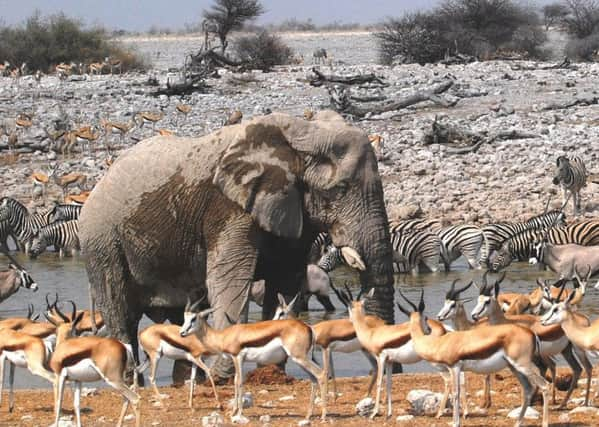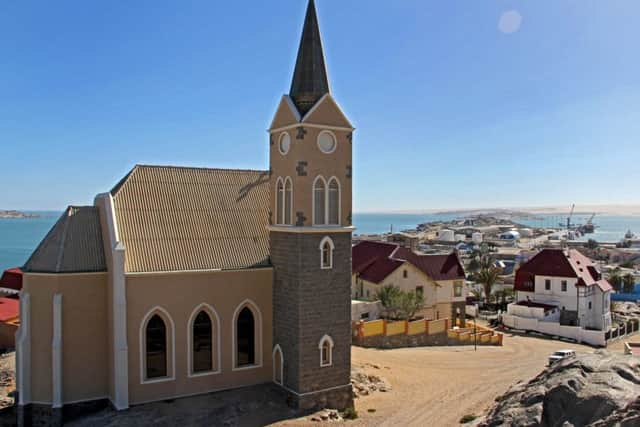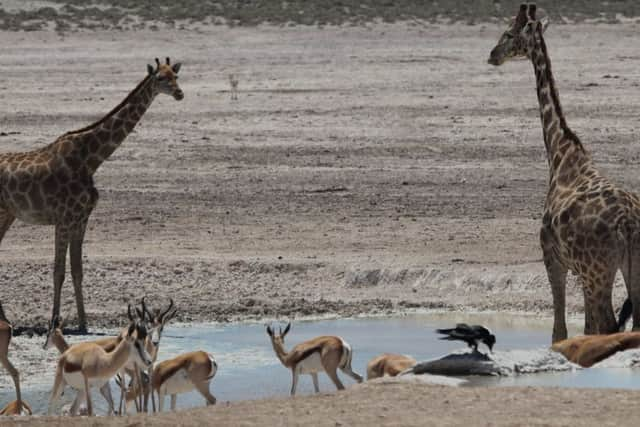Travel: Namibia


The size of Germany and Spain combined, Namibia has only 2.5 million inhabitants and the friction between humans and animals is low key. Elephants and rhinos are well protected, big cats roam the national parks and reserves and most days you’ll see as many animals as you do people.
The country is at peace with itself and its neighbours. There are no ethnic or religious issues waiting to erupt and, at a more mundane level, there is no jet leg for travellers from Scotland. The time difference is only two hours. A night flight to Johannesburg and a short hop to Windhoek or Swakopmund makes a self-drive holiday feasible from the moment you arrive in the country.
Advertisement
Hide AdAdvertisement
Hide AdUrban centres will have little place in your itinerary but Swakopmund is the exception. Cool all year, with an easy pace of life and German heritage – you’ll hear the language on the streets – it has the Namib desert on its doorstep. South of Swakopmund, the Namib desert meets the sea in 100 miles of towering banks of sand dunes, apparently without life of any kind but in fact a teeming mass of desert adapted plants and animals. Tommy’s Tours and Safaris takes you into the dunes to see the desert’s “little five”: geckos, sidewinder snakes, shovel snouted lizards, chameleons and scorpions. Tracking them down means gently digging them up and observing up close before carefully replacing them in their sandy homes. An eco-tour for sure but with speedy dune drives thrown in at the end.


Walvis Bay, half an hour’s drive from Swakopmund, offers boat trips to see whales, dolphins and leatherback turtles. From the shore, it’s free to feast your binoculars on a flamboyance of flamingos and quirky-looking pelicans
Two places stand out in Swakopmund for accommodation. The Delight has jazzy modern rooms, built around a walkway filled with hanging gardens, and a five-star buffet breakfast. On the edge of town, above the furious waves of the south Atlantic, is Beach Lodge. Rooms have brooding sea views, small kitchens and open fires; its fine-dining restaurant, The Wreck, has more ocean views through porthole-shaped windows.
Car journeys in Namibia are long and hot, the roads straight and mostly empty. Tarmac roads are a breeze to drive along but unpaved ones require concentration and slower speeds. Spitzkoppen Lodge is just under a 100 miles from Swakopmund but with the last 20 or so taking you into a vast and uninhabited region, this provides an exciting chapter in a Namibian adventure. The lodge consists of a series of elegant, solar-powered huts with all mod cons, complete privacy and epic views over the barren Spitzkoppe mountain range. A walk accesses a series of ancient rock paintings at the Small Bushman’s Paradise, giving a tiny glimpse into the spiritual lives of those who once subsisted in this barren place.
Equally remote is Ozondjou Trails bush camp, situated on the edge of the Ugab River. The river is dry for most of the year and becomes home to a herd of wandering desert elephants. Half a dozen solar-powered sleeping tents with attached bathrooms look out on the surrounding wilderness and a stay here includes a trip into the river bed tracking the elephants and spotting other wildlife along the way: hyenas, zebras, baboons, ostriches and a myriad birdlife from the silly-looking guinea fowl skittering about to flights of rosy-faced lovebirds and the honking of hornbills.


Etosha National Park is one of the largest national parks in Africa, with a salt pan at its centre and with all its roads navigable in a normal saloon car. Water holes scattered around the park attract wildlife like a magnet and it is easy to spend the best part of a day driving between the observation points: plenty of water, snacks, a camera and binoculars are the essentials. The 40mph speed limit allows time for wildebeest, oryx, springbok, ostriches, giraffes and warthogs to wander across the road. A zebra crossing takes on a whole new meaning in Etosha.
Of the many places to stay near Etosha, Ongava Game Reserve is metres from one of the Park’s gated entrances and its own reserve makes for magical, unforgettable evenings. Ongava’s dining area provides the ultimate floor show because it looks down on a floodlit waterhole, a wildlife amphitheatre, where large and small animals gather after dusk. If that isn’t enough, a hide sits on the edge of the water hole and brings you closer to wild rhinos than you might ever have expected.
An appropriate finale to a Namibian adventure is Okonjima and the Africat Foundation. A stay here combines a choice of stylish accommodation with the tracking of leopards and cheetahs which hang out along the dry river bed and surrounding bush. Sitting in an open jeep mere yards away from one of these elegant, dangerous creatures while they give you a disinterested stare is not easily forgotten. Such an experience is typical of Namibia, a country with a special appeal for travellers who want a holiday that will prove truly memorable.
FACT FILE
Advertisement
Hide AdAdvertisement
Hide Ad

Bradt’s Namibia travel guide is essential for planning your trip, while Freytag & Berndt’s road map could have a place in your vehicle. A half-day tour with Tommy’s Tours and Safaris (www.tommys.iway.na) is £42. For Etosha, see www.etoshanationalpark.org. For further information on Namibia see www.travelnamibia.co.uk.
An 11-night itinerary to Namibia covering Okonjima, Etosha, Spitzkoppe, Swakopmund and Windhoek costs from £3,230 per person based on two people travelling and includes flights, accommodation (three nights bed and breakfast, eight nights half board) and car rental. Book with Rainbow Tours (020 7666 1266, www.rainbowtours.co.uk). British Airways flies to Namibia’s capital, Windhoek, via London and Johannesburg.